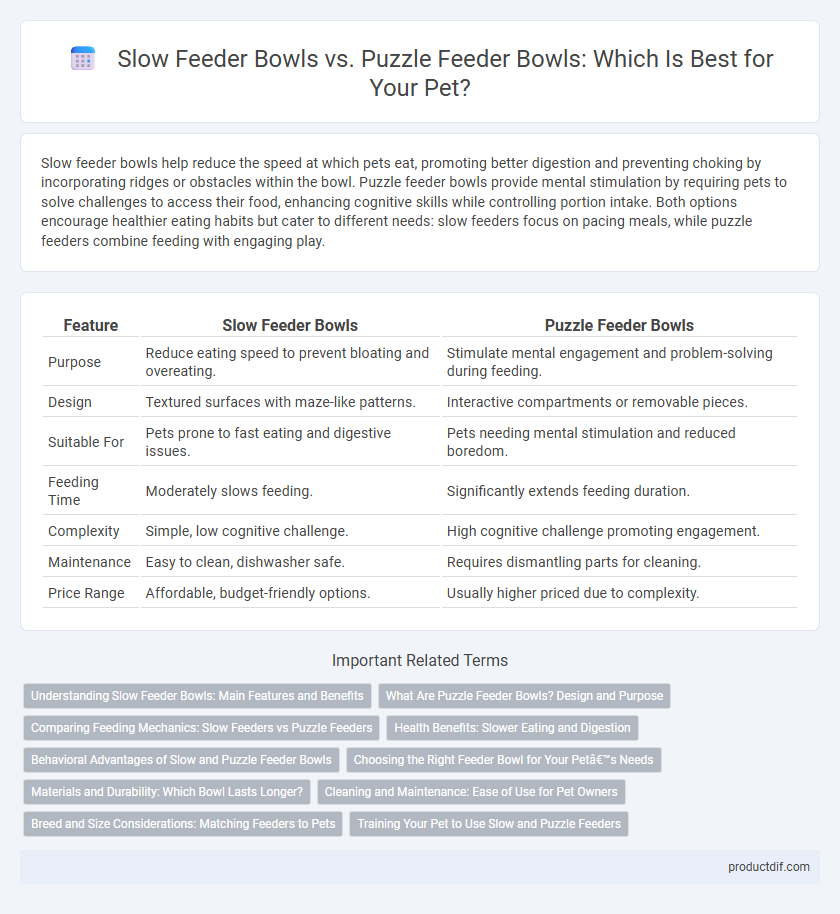Slow feeder bowls help reduce the speed at which pets eat, promoting better digestion and preventing choking by incorporating ridges or obstacles within the bowl. Puzzle feeder bowls provide mental stimulation by requiring pets to solve challenges to access their food, enhancing cognitive skills while controlling portion intake. Both options encourage healthier eating habits but cater to different needs: slow feeders focus on pacing meals, while puzzle feeders combine feeding with engaging play.
Table of Comparison
| Feature | Slow Feeder Bowls | Puzzle Feeder Bowls |
|---|---|---|
| Purpose | Reduce eating speed to prevent bloating and overeating. | Stimulate mental engagement and problem-solving during feeding. |
| Design | Textured surfaces with maze-like patterns. | Interactive compartments or removable pieces. |
| Suitable For | Pets prone to fast eating and digestive issues. | Pets needing mental stimulation and reduced boredom. |
| Feeding Time | Moderately slows feeding. | Significantly extends feeding duration. |
| Complexity | Simple, low cognitive challenge. | High cognitive challenge promoting engagement. |
| Maintenance | Easy to clean, dishwasher safe. | Requires dismantling parts for cleaning. |
| Price Range | Affordable, budget-friendly options. | Usually higher priced due to complexity. |
Understanding Slow Feeder Bowls: Main Features and Benefits
Slow feeder bowls are designed with ridges and obstacles to slow down a pet's eating pace, promoting better digestion and reducing risks of choking and bloat. These bowls are typically made from durable, non-toxic materials and come in various shapes to challenge pets while maintaining easy cleaning. Ideal for pets prone to overeating or digestive issues, slow feeder bowls encourage mindful eating and improve overall mealtime health.
What Are Puzzle Feeder Bowls? Design and Purpose
Puzzle feeder bowls are interactive pet feeding tools designed to stimulate mental engagement by requiring pets to solve challenges to access their food. These bowls incorporate compartments, barriers, or moving parts that encourage natural foraging behaviors and slow down eating, reducing risks like bloat or obesity. Their intricate design promotes cognitive development while providing physical activity, making them ideal for dogs and cats needing both mental and dietary enrichment.
Comparing Feeding Mechanics: Slow Feeders vs Puzzle Feeders
Slow feeder bowls utilize textured surfaces to prolong mealtime by forcing pets to eat around ridges or obstacles, reducing gulping and promoting digestion. Puzzle feeder bowls incorporate interactive elements like compartments or sliders that require pets to solve challenges to access food, enhancing mental stimulation along with slower eating. While slow feeders primarily focus on controlling intake speed, puzzle feeders combine feeding with cognitive engagement, making them suitable for pets needing both physical and mental enrichment during meals.
Health Benefits: Slower Eating and Digestion
Slow feeder bowls promote slower eating by incorporating ridges and obstacles, reducing the risk of bloating and improving digestion in pets. Puzzle feeder bowls enhance mental stimulation while also encouraging slower intake, which aids in preventing obesity and promotes better nutrient absorption. Both options support healthier eating habits by minimizing rapid gulping and promoting controlled, mindful feeding.
Behavioral Advantages of Slow and Puzzle Feeder Bowls
Slow feeder bowls and puzzle feeder bowls both enhance pets' mental stimulation by encouraging problem-solving and reducing boredom during mealtime. Slow feeder bowls promote healthier eating habits by preventing gulping and reducing the risk of digestive issues, while puzzle feeder bowls engage cognitive functions and can alleviate anxiety by providing interactive challenges. These behavioral advantages contribute to improved overall well-being and enriched daily routines for pets.
Choosing the Right Feeder Bowl for Your Pet’s Needs
Slow feeder bowls are designed to reduce eating speed by incorporating ridges and obstacles, promoting better digestion and preventing bloating in pets prone to gulping food. Puzzle feeder bowls engage pets mentally by requiring problem-solving skills to access food, which can help reduce boredom and encourage natural foraging behaviors. Selecting the right feeder depends on your pet's eating habits, activity level, and intellectual stimulation needs to ensure both physical health and mental engagement.
Materials and Durability: Which Bowl Lasts Longer?
Slow feeder bowls commonly feature durable materials like BPA-free plastic and stainless steel, designed to withstand chewing and daily use in various pets. Puzzle feeder bowls often use a combination of sturdy plastic and rubber components to create interactive challenges, but the moving parts may wear out faster than solid slow feeders. Overall, stainless steel slow feeders tend to last longer due to their resistance to scratches, bacteria, and breakage compared to puzzle feeders with multiple pieces.
Cleaning and Maintenance: Ease of Use for Pet Owners
Slow feeder bowls feature simple designs with wide openings, making them easier to clean and maintain compared to puzzle feeder bowls that have intricate compartments and crevices where food can get trapped. Puzzle feeder bowls often require hand washing and thorough scrubbing to remove hidden food residues, increasing the time and effort involved in upkeep. Pet owners seeking low-maintenance options tend to prefer slow feeder bowls for their convenience and quick cleaning processes.
Breed and Size Considerations: Matching Feeders to Pets
Slow feeder bowls are ideal for large breeds prone to eating quickly, helping to prevent choking and digestive issues by controlling portion size and pacing. Puzzle feeder bowls suit highly intelligent or small breeds that require mental stimulation during feeding, promoting prolonged engagement and reducing boredom. Selecting feeders based on breed size and cognitive traits ensures tailored feeding experiences that support health and behavior.
Training Your Pet to Use Slow and Puzzle Feeders
Training your pet to use slow feeder bowls involves introducing meals gradually with positive reinforcement to reduce anxiety around slower eating. Puzzle feeder bowls stimulate pets mentally by challenging them to solve feeding puzzles, requiring consistent practice and patience for mastery. Both feeder types improve eating habits and cognitive skills, promoting healthier digestion and enhanced problem-solving abilities in pets.
Slow feeder bowls vs puzzle feeder bowls Infographic

 productdif.com
productdif.com